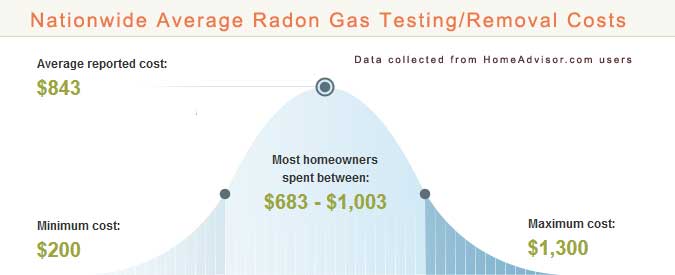Last Updated: February 15, 2023
Radon Gas Testing and Removal Services Cost
Try Our Free Radon Gas Removal Calculator
Fill out our 30 second free form to receive competitive pricing from pre-screened testing & removal companies. No commitments. Our service is always free!
Radon is a radioactive gas that naturally occurs when uranium breaks down in soil, rocks and water. It can seep into homes and buildings through cracks in the foundation and other openings, and it can be found in well water.
Radon is impossible to detect without testing because it is colorless and odorless; however, long-term exposure is very dangerous. According to the U.S. Environmental Protection Agency (EPA), radon is the leading cause of cancer in non-smokers and the No. 2 cause of lung cancer in general.
Should I Have My Home or Building Tested?
The EPA and the Surgeon General recommend radon testing for all homes and schools, and they recommend measures to reduce radon in homes or buildings with high levels. Any amount of radon above 0.4 picocuries per liter of air (pCi/L) - the level found outdoors - is considered high.
There are two types of tests: short term and long term. Short-terms tests remain in the home for 48 hours to 90 days, while long-term tests remain in the home for longer than 90 days. Generally, long-term tests are better because they produce more accurate results. Some people test for radon using do-it-yourself kits, but many choose to hire a trained professional for peace of mind that the test has been administered properly and the results are accurate. For anyone buying or selling a home, the EPA recommends hiring a professional.

How Does Radon Mitigation Work?
Radon mitigation is the technical term for taking measures to reduce the level of radon in a home or building. The EPA recommends taking action for any structure with levels higher than 0.4 pCi/L, but the agency cautions that you also may want to consider mitigation if testing turns up levels above 2 pCi/L.
Radon mitigation is usually handled by a trained professional, and there are several methods that can be used. The most common, according to the EPA, is called a soil suction radon reduction system. Essentially, it is a vent pipe and fan system that pulls radon from underneath the home and vents it outside. However, the best approach to mitigation always depends on the design and condition of your home, so you should always consult a radon professional for advice.
Try Our Free Radon Gas Removal Calculator
Fill out our 30 second free form to receive competitive pricing from pre-screened testing & removal companies. No commitments. Our service is always free!
How Much Do These Services Cost?
Short-term DIY test kits cost about $10 to $20, while long-term DIY kits sell for about $20 to $50. Professional testing usually costs about $100 to $200. If you’re buying a home, radon testing usually can be included in the home inspection for an additional fee.
Radon mitigation varies in price depending on the the extent of the problem, the configuration of your home, the method of mitigation and your geographic location. Generally, plan on spending anywhere from about $800 to $2,000.
Choosing a Radon Professional
It’s difficult to overstate the importance of choosing the right company for radon mitigation. You’re dealing with a substance that is linked to some 20,000 deaths each year. The company you hire has to be experienced and reputable. Here are some tips for finding the right company for the job
- Never hire the same company for testing and mitigation. The tester has an incentive to report high levels of radon if he or she is going to be paid to fix the problem. Most companies are honest, but don’t chance it.
- Contact your state radon office before hiring anyone for information on whether radon professionals must licensed, registered or certified. The EPA provides contact information for each state here. State officials may also be to provide information on areas that are known to have radon problems.
- If your state does not regulate radon professionals or does not have a radon office, contact one of the private radon programs for a list of accredited or certified radon contractors in your area. There are two private programs: National Radon Proficiency Program (NRPP) and National Radon Safety Board (NRSB).
- Always do background research on any company you’re thinking of hiring. Check the company’s rating with the Better Business Bureau. Ask for references and call them all. Make sure the company has a website and a legitimate mailing address. If anything about the company doesn’t seem right, move on.
Find the Best Testing & Removal Pros Who Will Compete for Your Business
Try Our Free Radon Gas Removal Calculator
Fill out our 30 second free form to receive competitive pricing from pre-screened testing & removal companies. No commitments. Our service is always free!
Try Our Free Radon Gas Removal Calculator
Fill out our 30 second free form to receive competitive pricing from pre-screened testing & removal companies. No commitments. Our service is always free!